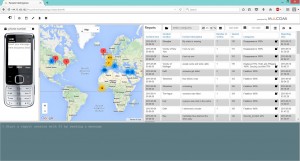The PI Demo is Online
Dear Friends of PI,
Over the last months, thanks to a USAID grant awarded to PI as one of the winners of the Tech Challenge for Atrocity Prevention co-sponsored by Humanity United we successfully developed a web based demo of some of the PI features. At this stage the demo is based on an incident report scenario. We invite you to visit our Demo page to access the demo and test out some of its features.
Given our time and resource constraints, we had to choose a few features we wished to demonstrate. The Demo as it stands is far from a finished and polished product. Important PI Features such as the provision of actionable feedback to those reporting information still need to be developed, while all of the current features can be greatly enhanced, including with more advanced natural language processing algorithms.
This being said, with the demo as it stands you can put yourself in the shoes of an untrained person and
- Contact the PI platform and report an incident by answering a number of questions via text messaging.
Or from the perspective of a staff member of one of the organizations running PI:
- See how the PI Demo facilitates the collection of structured data which are automatically geotagged;
- Experience how the PI Demo automatically triages reports along pre-established thematic categories;
- You can adjust the level of confidence that a given report is clustered within a certain category;
- You can triangulate reports which share similar characteristics including a date, a proximate location and at least one thematic category;
- You refine the list of keywords defining each thematic category to improve automatic categorization by the PI Demo;
- And of course, you can view and sort reports by geographic area, categories and time.
We invite all our demo users to complete a survey where we will gather first impressions as well as ideas how to improve our software.
Our intention is to use this demo as a basis to discuss the development of PI’s core features, the design of thematic questionnaires and their underlying questions’ logic with PI’s stakeholders.
We also hope to use the PI Demo to raise awareness that it is possible to automate a great number of information management processes.
Lessons learned: During the design phase of the PI architecture and the development efforts of the PI Demo, we quickly learned the importance of regular face to face quality conversations with the developers’ team. As soon as a first version of the demo was coded, we tested it and communicated what worked seamlessly, bugs to be corrected and changes to features that worked but that needed to be rendered differently. Developers went back to work, delivered a new version, which we tested again. The process ended when we were happy that the features had been rendered as per the agreed specifications and all remaining bugs had been corrected.
The number of processes implemented as well as the algorithmic complexity of the Demo also provide us with an indication of the amount of efforts that will be needed to design the PI platform. It will require sustained development efforts to improve current natural language processing algorithms combined with machine learning capabilities and develop the remaining features of the PI platform. Its development will necessitate close interactions with PI stakeholders whose inputs during the design and testing phases will form the socle of PI’s development efforts.








